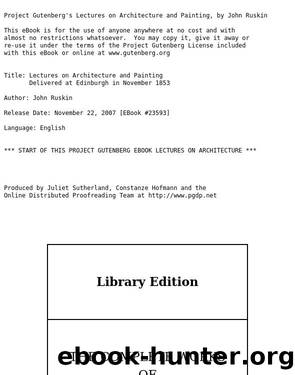Lectures on Architecture and Painting, Delivered at Edinburgh in November 1853 by John Ruskin

Author:John Ruskin [Ruskin, John]
Language: eng
Format: epub
Tags: Painting, Architecture, Turner, J. M. W. (Joseph Mallord William), 1775-1851, Pre-Raphaelitism
Published: 2007-11-21T16:00:00+00:00
69. A. Conventionalism by cause of color.âAbstract color is not an imitation of nature, but is nature itself; that is to say, the pleasure taken in blue or red, as such, considered as hues merely, is the same, so long as the brilliancy of the hue is equal, whether it be produced by the chemistry of man, or the chemistry of flowers, or the chemistry of skies. We deal with color as with soundâso far ruling the power of the light, as we rule the power of the air, producing beauty not necessarily imitative, but sufficient in itself, so that, wherever color is introduced, ornamentation may cease to represent natural objects, and may consist in mere spots, or bands, or flamings, or any other condition of arrangement favorable to the color.
70. B. Conventionalism by cause of inferiority.âIn general, ornamentation is set upon certain services, subjected to certain systems, and confined within certain limits; so that its forms require to be lowered or limited in accordance with the required relations. It cannot be allowed to assume the free outlines, or to rise to the perfection of imitation. Whole banks of flowers, for instance, cannot be carved on cathedral fronts, but only narrow moldings, having some of the characters of banks of flowers. Also, some ornaments require to be subdued in value, that they may not interfere with the effect of others; and all these necessary inferiorities are attained by means of departing from natural formsâit being an established law of human admiration that what is most representative of nature shall, cæteris paribus, be most attractive.
All the various kinds of ornamentation, consisting of spots, points, twisted bands, abstract curves, and other such, owe their peculiar character to this conventionalism "by cause of inferiority."
71. C. Conventionalism by cause of means.âIn every branch of art, only so much imitation of nature is to be admitted as is consistent with the ease of the workman and the capacities of the material. Whatever shortcomings are appointed (for they are more than permitted, they are in such cases appointed, and meritorious) on account of the untractableness of the material, come under the head of "conventionalism by cause of means."
These conventionalities, then, being duly understood and accepted, in modification of the general law, that law will be, that the glory of all ornamentation consists in the adoption or imitation of the beauties of natural objects, and that no work can be of high value which is not full of this beauty. To this fourth proposition, modern architects have not ventured to make any serious resistance. On the contrary, they seem to be, little by little, gliding into an obscure perception of the fact, that architecture, in most periods of the world, had sculpture upon it, and that the said sculpture generally did represent something intelligible. For instance, we find Mr. Huggins, of Liverpool, lately lecturing upon architecture "in its relations to nature and the intellect,"[25] and gravely informing his hearers, that "in the Middle Ages angels were human
Download
This site does not store any files on its server. We only index and link to content provided by other sites. Please contact the content providers to delete copyright contents if any and email us, we'll remove relevant links or contents immediately.
Learn Drawing Quickly by Sharon Finmark(2090)
The Husband's Secret by Liane Moriarty(2042)
Drawing and Painting Birds by Tim Wootton(2001)
The Unlikely Pilgrimage of Harold Fry by Rachel Joyce(1836)
Classical Drawing Atelier by Juliette Aristides(1775)
One Drawing A Day by Veronica Lawlor(1495)
The Art of Creative Watercolor by Danielle Donaldson(1451)
Oil Painting For Dummies by Anita Marie Giddings & Sherry Stone Clifton(1396)
Anywhere, Anytime Art: Crayon by Monika Forsberg(1313)
Hieronymus Bosch by Virginia Pitts Rembert(1309)
Special Subjects: Basic Color Theory by Patti Mollica(1294)
Post-Impressionism by Nathalia Brodskaya(1288)
Woman's Mysteries by Esther Harding(1246)
Elizabeth Is Missing by Emma Healey(1231)
Memory's Wake by Fenech Selina(1186)
Fundamentals of Drawing by Barrington Barber(1058)
Acrylic Fusion by Dan Tranberg(1027)
Landscape Painting in Pastel by Elizabeth Mowry(1022)
Drawing by William Powell(1000)
